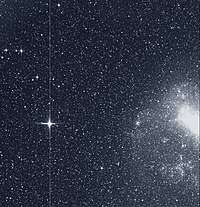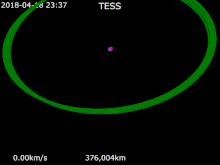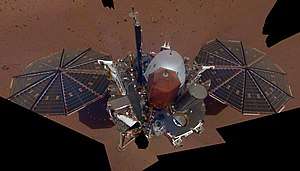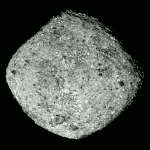Transiting Exoplanet Survey Satellite
The Transiting Exoplanet Survey Satellite (TESS) is a space telescope for NASA's Explorers program, designed to search for exoplanets using the transit method in an area 400 times larger than that covered by the Kepler mission.[6] It was launched on April 18, 2018 atop a Falcon 9 rocket and was placed into a highly elliptical 13.7-day orbit around the Earth.[6][2][7][8][9] During its two-year primary mission, it was expected to find more than 20,000 transiting exoplanets,[10] compared to about 3,800 exoplanets known when it launched.[11] As of April 18, 2020, which marks the end of the originally planned mission, TESS has identified just 1785 candidate exoplanets, of which 45 have been confirmed so far.[12] The first light image from TESS was taken on August 7, 2018, and released publicly on September 17, 2018.[1][13][14]
.png) Artist concept of TESS | |
| Mission type | Space observatory[1][2] |
|---|---|
| Operator | NASA / MIT |
| COSPAR ID | 2018-038A |
| SATCAT no. | 43435 |
| Website | tess tess |
| Mission duration | Planned: 2 years Elapsed: 2 years, 7 days |
| Spacecraft properties | |
| Bus | LEOStar-2/750[3] |
| Manufacturer | Orbital ATK |
| Launch mass | 362 kg (798 lb)[4] |
| Dimensions | 3.7 × 1.2 × 1.5 m (12 × 4 × 5 ft) |
| Power | 530 watts[4] |
| Start of mission | |
| Launch date | April 18, 2018, 22:51:31 UTC[5] |
| Rocket | Falcon 9 Block 4 (B1045.1) |
| Launch site | Cape Canaveral SLC-40 |
| Contractor | SpaceX |
| Orbital parameters | |
| Reference system | Highly elliptical |
| Regime | High Earth |
| Semi-major axis | 240,000 km (150,000 mi) |
| Eccentricity | 0.55 |
| Perigee altitude | 108,000 km (67,000 mi) |
| Apogee altitude | 375,000 km (233,000 mi) |
| Inclination | 37° |
| Period | 13.7 days |
| Epoch | Planned |
.png) Medium Explorers program | |
| Wikinews has related news: NASA launches exoplanet-hunting satellite TESS |
The primary mission objective for TESS is to survey the brightest stars near the Earth for transiting exoplanets over a two-year period. The TESS satellite uses an array of wide-field cameras to perform a survey of 85% of the sky. With TESS, it is possible to study the mass, size, density and orbit of a large cohort of small planets, including a sample of rocky planets in the habitable zones of their host stars. TESS will provide prime targets for further characterization by the James Webb Space Telescope, as well as other large ground-based and space-based telescopes of the future. While previous sky surveys with ground-based telescopes have mainly detected giant exoplanets and the Kepler space telescope has mostly found planets around distant stars that are too faint for characterisation, TESS will find many small planets around the nearest stars in the sky. TESS records the nearest and brightest main sequence stars hosting transiting exoplanets, which are the most favorable targets for detailed investigations.[15]
TESS uses a novel highly-elliptical orbit around the Earth with an apogee approximately at the distance of the Moon and a perigee of 108,000 km. TESS orbits Earth twice during the time the Moon orbits once, a 2:1 resonance with the Moon.[16] The orbit is expected to remain stable for a minimum of ten years.
Led by the Massachusetts Institute of Technology with seed funding from Google,[17] on April 5, 2013, it was announced that TESS, along with the Neutron Star Interior Composition Explorer (NICER), had been selected by NASA for launch.[18][19]
History
The concept of TESS was first discussed in 2005 by the Massachusetts Institute of Technology (MIT) and the Smithsonian Astrophysical Observatory (SAO).[20] The genesis of TESS was begun during 2006, when a design was developed from private funding by individuals, Google, and The Kavli Foundation.[21] In 2008, MIT proposed that TESS become a full NASA mission and submitted it for the Small Explorer program at Goddard Space Flight Center,[21] but it was not selected.[22] It was resubmitted in 2010 as an Explorers program mission, and was approved in April 2013 as a Medium Explorer mission.[23][21][24] TESS passed its critical design review (CDR) in 2015, allowing production of the satellite to begin.[21] While Kepler had cost US$640 million at launch, TESS cost only US$200 million (plus US$87 million for launch).[25][26] The mission will find exoplanets that periodically block part of the light from their host stars, events called transits. TESS will survey 200,000 of the brightest stars near the sun to search for transiting exoplanets. TESS launched on April 18, 2018, aboard a SpaceX Falcon 9 rocket.
Mission overview
TESS is designed to carry out the first spaceborne all-sky transiting exoplanet survey.[18][27] It is equipped with four wide-angle telescopes and associated charge-coupled device (CCD) detectors. Science data are transmitted to Earth every two weeks. Full-frame images with an effective exposure time of two hours will be transmitted as well, enabling scientists to search for unexpected, transient phenomena, such as the optical counterparts to gamma-ray bursts. TESS also hosts a Guest Investigator program, allowing scientists from other organizations to use TESS for their own research. The resources allocated to Guest programs allow an additional 20,000 celestial bodies to be observed.[28]
Orbital dynamics
In order to obtain unobstructed imagery of both the northern and southern hemispheres of the sky, TESS utilizes a 2:1 lunar resonant orbit called P/2, an orbit that has never been used before (although IBEX uses a similar P/3 orbit). The highly elliptical orbit has a 373,000 km (232,000 mi) apogee, timed to be positioned approximately 90° away from the position of the Moon to minimize its destabilizing effect. This orbit should remain stable for decades and will keep TESS's cameras in a stable temperature range. The orbit is entirely outside the Van Allen belts to avoid radiation damage to TESS, and most of the orbit is spent far outside the belts. Every 13.7 days at its perigee of 108,000 km (67,000 mi), TESS will downlink to Earth over a period of approximately 3 hours the data it has collected during the just finished orbit.[29]
Science objectives
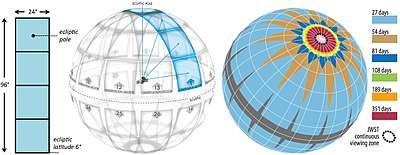
TESS's two-year all-sky survey will focus on nearby G-, K-, and M-type stars with apparent magnitudes brighter than magnitude 12.[30] Approximately 200,000 stars will be studied, including the 1,000 closest red dwarfs across the whole sky,[31][32] an area 400 times larger than that covered by the Kepler mission.[31] TESS is expected to discover more than 20,000 transiting exoplanets, including 500 to 1000 Earth-sized planets and super-Earths.[10] Of those discoveries, an estimated 20 could be super-Earths located in the habitable zone around a star.[33] The stated goal of the mission is to determine the masses of at least 50 Earth-sized planets (at most 4 times earth radii).[34] Most detected exoplanets are expected to be between 30 and 300 light-years away.
The survey is broken up into 26 observation sectors, each sector being 24° × 96°, with an overlap of sectors at the ecliptic poles to allow additional sensitivity toward smaller and longer-period exoplanets in that region of the celestial sphere. The spacecraft will spend two 13.7-day orbits observing each sector, mapping the southern hemisphere of sky in its first year of operation and the northern hemisphere in its second year.[35] The cameras actually take images every 2 seconds, but all the raw images would represent much more data volume than can be stored or downlinked. To deal with this, cutouts around 15,000 selected stars (per orbit) will be coadded over a 2-minute period and saved on board for downlink, while full-frame images will also be coadded over a 30-minute period and saved for downlink. The actual data downlinks will occur every 13.7 days near perigee.[36] This means that during the 2 years, TESS will continuously survey 85% of the sky for 27 days, with certain parts being surveyed across multiple runs. The survey methodology was designed such that the area that will be surveyed, essentially continuously, over an entire year (351 observation days) and makes up about 5% of the entire sky, will encompass the regions of sky (near the ecliptic poles) which will be observable at any time of year with the JWST.[37]
In October 2019, Breakthrough Listen started a collaboration with scientists from the TESS team to look for signs of advanced extraterrestrial life. Thousands of new planets found by TESS will be scanned for "technosignatures" by Breakthrough Listen partner facilities across the globe. Data from TESS monitoring of stars will also be searched for anomalies.[38]
Asteroseismology
The TESS team also plans to use a 30-minute observation cadence for full-frame images, which has been noted for imposing a hard Nyquist limit that can be problematic for asteroseismology of stars.[39] Asteroseismology is the science that studies the internal structure of stars by the interpretation of their frequency spectra. Different oscillation modes penetrate to different depths inside the star. The Kepler and PLATO observatories are also intended for asteroseismology.[40]
Launch
.jpg)
In December 2014, SpaceX was awarded the contract to launch TESS in August 2017,[41] for a total contract value of US$87 million.[42] The 362 kg spacecraft was originally scheduled to launch on March 20, 2018, but this was pushed back by SpaceX to allow additional time to prepare the launch vehicle and meet NASA launch service requirements.[43] A static fire of the Falcon 9 rocket was completed on April 11, 2018, at approximately 18:30 UTC.[44] The launch was postponed again from April 16, 2018,[7] and TESS was eventually launched on a SpaceX Falcon 9 rocket from the SLC-40 launch site at Cape Canaveral Air Force Station on April 18.[8][9]
The Falcon 9 launch sequence included a 149-second burn by the first stage, followed by a 6-minute second stage burn. Meanwhile, the first-stage booster performed controlled-reentry maneuvers and successfully landed on the autonomous drone ship Of Course I Still Love You. After coasting for 35 minutes, the second stage performed a final 54-second burn that placed TESS into a supersynchronous transfer orbit of 200 by 270,000 km at an inclination of 28.5 degrees.[45][46] The second stage released the payload, after which the stage itself was placed in a heliocentric orbit. An experimental water landing was performed for the fairing,[45] as part of SpaceX's attempt to develop fairing reusability.
Spacecraft
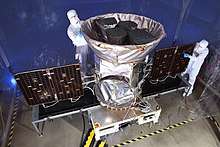
In 2013, Orbital Sciences received a four-year, US$75 million contract to build TESS for NASA.[47] TESS uses an Orbital Sciences LEOStar-2 satellite bus, capable of three-axis stabilization using four hydrazine thrusters plus four reaction wheels providing better than three arc-second fine spacecraft pointing control. Power is provided by two single-axis solar arrays generating 400 watts. A Ka-band dish antenna provides a 100 Mbit/s science downlink.[31][48]
Operational orbit
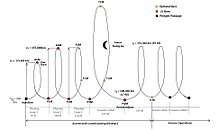
Once injected into the initial orbit by the Falcon 9 second stage, the spacecraft performed four additional independent burns that placed it into a lunar flyby orbit.[49] On May 17, the spacecraft underwent a gravity assist by the Moon at 8,253.5 km (5,128.5 mi) above the surface,[50] and performed the final period adjustment burn on May 30.[51] It achieved an orbital period of 13.65 days in the desired 2:1 resonance with the Moon, at 90 degrees phase offset to the Moon at apogee, which is expected to be a stable orbit for at least 20 years, thus requiring very little fuel to maintain.[8] The entire maneuvering phase was expected to take a total of two months, and bring the craft in an eccentric orbit (17–75 R⊕) at a 37° inclination. The total delta-v budget for orbit maneuvers was 215 m/s (710 ft/s), which is 80% of the mission's total available reserves. If TESS receives an on-target or slightly above nominal orbit insertion by the Falcon 9, a theoretical mission duration in excess of 15 years would be possible from a consumables standpoint.[46]
Project timeline
The first light image was made on August 7, 2018, and released publicly on September 17, 2018.[1][13][14][52]
TESS completed its commissioning phase at the end of July and the science phase officially started on July 25.[53]
For the first two years of operation TESS monitored both the southern (year 1) and northern (year 2) celestial hemispheres. During its nominal mission TESS tiles the sky in 26 separate segments, with a 27.4-day observing period per segment.[35]
Scientific instrumentation
The sole instrument on TESS is a package of four wide-field-of-view CCD cameras. Each camera features four low-noise, low-power 4 megapixel CCDs created by MIT Lincoln Laboratory. The four CCDs are arranged in a 2x2 detector array for a total of 16 megapixels per camera and 16 CCDs for the entire instrument. Each camera has a 24° × 24° field of view, a 100 mm (4 in) effective pupil diameter, a lens assembly with seven optical elements, and a bandpass range of 600 to 1000 nm.[31][3] The TESS lenses have a combined field of view of 24° × 96° (2,300 deg2, around 5% of the entire sky) and a focal ratio of f/1.4. The ensquared energy, the fraction of the total energy of the point-spread function that is within a square of the given dimensions centered on the peak, is 50% within 15 × 15 μm and 90% within 60 × 60 μm.[3] For comparison, Kepler's primary mission only covered an area of the sky measuring 105 deg2, though the K2 extension has covered many such areas for shorter times.
Ground operations
The TESS ground system is divided between eight sites around the United States. These include NASA's Space Network and the Jet Propulsion Laboratory's Deep Space Network for command and telemetry, Orbital ATK's Mission Operations Center, MIT's Payload Operations Center, the Ames Research Center's Science Processing Operations Center, The Goddard Space Flight Center's Flight Dynamics Facility, the Smithsonian Astrophysical Observatory's TESS Science Office, and the Mikulski Archive for Space Telescopes (MAST).[54]
Stable light source for tests
One of the issues facing the development of this type of instrument is having an ultra-stable light source to test on. In 2015, a group at the University of Geneva made a breakthrough in the development of a stable light source. While this instrument was created to support ESA's CHEOPS exoplanet observatory, one was also ordered by the TESS program.[55] Although both observatories plan to look at bright nearby stars using the transit method, CHEOPS is focused on collecting more data on known exoplanets, including those found by TESS and other survey missions.[56]
Results
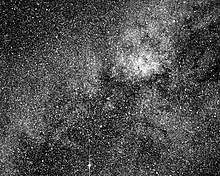
TESS team partners include the Massachusetts Institute of Technology, the Kavli Institute for Astrophysics and Space Research, NASA's Goddard Space Flight Center, MIT's Lincoln Laboratory, Orbital ATK, NASA's Ames Research Center, the Harvard-Smithsonian Center for Astrophysics, and the Space Telescope Science Institute.
TESS started science operations on July 25, 2018.[57] The first announced finding from the mission was the observation of comet C/2018 N1.[57] The first exoplanet detection announcement was on September 18, announcing the discovery of a super-Earth in the Pi Mensae system orbiting the star every 6 days, adding to a known super-Jupiter orbiting the same star every 5.9 years.[58]
On September 20, 2018, the discovery of an ultra-short period planet was announced, slightly larger than Earth, orbiting the red dwarf LHS 3844. With an orbital period of 11 hours, LHS 3844 b is one of the planets with the shortest known period. It orbits its star at a distance of 932,000 kilometres (579,000 mi). LHS 3844 b is also one of the closest known exoplanets to Earth, at a distance of 14.9 parsec.[59]
TESS's third discovered exoplanet is HD 202772A b, a hot Jupiter orbiting the brighter component of the visual binary star HD 202772, located in the constellation Capricornus at a distance of about 480 light-years from Earth. The discovery was announced on October 5, 2018. HD 202772A b orbits its host star once every 3.3 days. It is an inflated hot Jupiter, and a rare example of hot Jupiters around evolved stars. It is also one of the most strongly irradiated planets known, with an equilibrium temperature of 2,100 K (1,830 °C; 3,320 °F).[60]
On April 15, 2019 TESS' first discovery of an earth-sized planet was reported. HD 21749 c is a rocky planet with about 89% of Earth's diameter and orbits the K-type main sequence star HD 21749 in about 8 days. The planet's surface temperature is estimated to be as high as 427 °C. Both known planets in the system, HD 21749 b and HD 21749 c, were discovered by TESS. HD 21749 c represents the 10th confirmed planet discovery by TESS.[61]
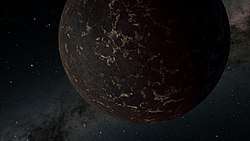
Data on exoplanet candidates continue to be made available at MAST.[62] As of April 20, 2019, the total number of candidates on the list was up to 335. Besides candidates identified as previously discovered exoplanets, this list also includes ten newly discovered exoplanets, including the five mentioned above. Forty-four of the candidates from Sector 1 in this list were selected for follow-up observations by the TESS Follow-Up Program (TFOP), which aims to aid the discovery of 50 planets with a planetary radius of R < 4R⊕ through repeated observations.[63] The list of candidate exoplanets continues to grow as additional results are being published on the same MAST page.
On July 18, 2019, after the first year of operation the southern portion of the survey was completed, now it turns its cameras to the Northern Sky. As of this time it has discovered 21 planets and has over 850 candidate exoplanets.[64]

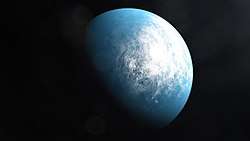
On July 23, 2019, the discovery of the young exoplanet DS Tuc Ab (HD 222259Ab) in the ~45 Myr old Tucana-Horologium young moving group was published in a paper. TESS did first observe the planet in November 2018 and it was confirmed in March 2019. The young planet is larger than Neptune, but smaller than Saturn. The system is bright enough to follow up with radial velocity and transmission spectroscopy.[65][66] ESA's CHEOPS mission will observe the transits of the young exoplanet DS Tuc Ab. A team of scientists got 23.4 orbits approved in the first Announcement of Opportunity (AO-1) for the CHEOPS Guest Observers (GO) Programme to characterize the planet.[67]
On July 31, 2019, the discovery of exoplanets around the M-type dwarf star GJ 357 at a distance of 31 light years from Earth was announced.[68] TESS directly observed the transit of GJ 357 b, a hot earth with an equilibrium temperature of around 250°C. Follow-up ground observations and analyses of historic data lead to the discovery of GJ 357 c and GJ 357 d. While GJ 357 b and GJ 357 c are too close to the star to be habitable, GJ 357 d resides at the outer edge of the star's habitable zone and may possess habitable conditions if it has an atmosphere. With at least 6.1 M⊕ it is classified as a Super-Earth. [68]
As of September 2019, over 1000 TESS Objects of Interest (ToI) have been listed in the public database,[69] at least 29 of which are confirmed planets, about 20 of which within the stated goal of the mission of Earth-sized (<4 Earth radii).[70]
On September 26, 2019, it was announced that TESS did observe its first tidal disruption event (TDE), called ASASSN-19bt. The TESS data revealed that ASASSN-19bt began to brighten on January 21, 2019, ~8.3 days before the discovery by ASAS-SN.[71][72]
On January 6, 2020, NASA reported the discovery of TOI 700 d, the first Earth-sized exoplanet in the habitable zone discovered by the TESS. The exoplanet orbits the star TOI 700 100 light-years away in the Dorado constellation.[73] The TOI 700 system contains two other planets: TOI 700b, another Earth-sized planet and TOI-700c, a super-Earth. This system is unique in that the larger planet is found between the two smaller planets. It is currently unknown how this arrangement of planets came to be, whether these planets formed in this order or if the larger planet migrated to its current orbit.[74] On the same day NASA announced that astronomers used TESS data to show that Alpha Draconis is an eclipsing binary star.[75] The same day, the discovery of TOI 1338 b was announced, the first circumbinary planet discovered with TESS. TOI 1338 b is around 6.9 times larger than Earth, or between the sizes of Neptune and Saturn. It lies in a system 1,300 light-years away in the constellation Pictor. The stars in the system make an eclipsing binary, which occurs when the stellar companions circle each other in our plane of view. One is about 10% more massive than our Sun, while the other is cooler, dimmer and only one-third the Sun's mass. TOI 1338b's transits are irregular, between every 93 and 95 days, and vary in depth and duration thanks to the orbital motion of its stars. TESS only sees the transits crossing the larger star — the transits of the smaller star are too faint to detect. Although the planet transits irregularly, its orbit is stable for at least the next 10 million years. The orbit's angle to us, however, changes enough that the planet transit will cease after November 2023 and resume eight years later.[76]
See also
- ARIEL, 2028 exoplanet atmospheres observatory
- CHEOPS, 2019 exoplanet observatory
- COROT, 2006–2012 exoplanet observatory
- Kepler, 2009–2018 exoplanet observatory
- MOST, 2003–2019 asteroseismology and exoplanet observatory
- PLATO, 2026 exoplanet observatory
- SWEEPS, 2006 Hubble exoplanet survey
- List of transiting exoplanets
References
- Overbye, Dennis (September 20, 2018). "NASA's TESS Starts Collecting Planets - The satellite, launched in April, has already identified at least 73 stars that may harbor exoplanets, most of them new to astronomers". NASA. Retrieved September 23, 2018.
- Overbye, Dennis (March 26, 2018). "Meet Tess, Seeker of Alien Worlds". The New York Times. Retrieved March 26, 2018.
- Ricker, George R.; Winn, Joshua N.; Vanderspek, Roland; et al. (January–March 2015). "Transiting Exoplanet Survey Satellite" (PDF). Journal of Astronomical Telescopes, Instruments, and Systems. 1 (1). 014003. arXiv:1406.0151. Bibcode:2015JATIS...1a4003R. doi:10.1117/1.JATIS.1.1.014003.
- "TESS: Discovering Exoplanets Orbiting Nearby Stars - Fact Sheet" (PDF). Orbital ATK. 2018.
- Gebhardt, Chris (April 18, 2018). "SpaceX successfully launches TESS on a mission to search for near-Earth exoplanets". NASASpaceFlight.com. Retrieved May 20, 2018.
- "Transiting Exoplanet Survey Satellite". SPIE Digital Library. October 24, 2014. Retrieved April 3, 2020.
- "Launch Schedule". Spaceflight Now. February 27, 2018. Retrieved February 28, 2018.
- Amos, Jonathan (April 19, 2018). "Planet-hunter launches from Florida". BBC News.
- "NASA Planet Hunter on Its Way to Orbit". NASA. April 19, 2018. Retrieved April 19, 2018.
- Cooper, Keith (April 13, 2018). "The Astrobiology Magazine Guide to TESS". Retrieved April 14, 2018.
- Schneider, J. "Interactive Extra-solar Planets Catalog". The Extrasolar Planets Encyclopedia. Retrieved April 14, 2018.
- "TESS findings".
- Kazmierczak, Jeanette; Garner, Rob (September 17, 2018). "NASA's TESS Shares First Science Image in Hunt to Find New Worlds". NASA. Retrieved September 23, 2018.
- Wiessinger, Scott; Lepsch, Aaron E.; Kazmierczak, Jeanette; Reddy, Francis; Boyd, Padi (September 17, 2018). "NASA's TESS Releases First Science Image". NASA. Retrieved September 23, 2018.
- "NASA FY 2015 President's Budget Request Summary" (PDF). NASA. March 10, 2014.
- McGiffin, Daniel A.; Mathews, Michael; Cooley, Steven (June 1, 2001). HIGH EARTH ORBIT DESIGN FOR LUNAR-ASSISTED MEDIUM CLASS EXPLORER MISSIONS. Greenbelt, MD: NASA Goddard Space Flight Center.
- Chandler, David (March 19, 2008). "MIT aims to search for Earth-like planets with Google's help". MIT News.
- Harrington, J. D. (April 5, 2013). "NASA Selects Explorer Investigations for Formulation" (Press release). NASA.
- "NASA selects MIT-led TESS project for 2017 mission". MIT News. April 5, 2013. Retrieved April 6, 2013.
- Ricker, George R.; Winn, Joshua N.; Vanderspek, Roland; Latham, David W.; Bakos, Gaspar A.; Bean, Jacob L.; Berta-Thompson, Zachory K.; Brown, Timothy M.; Buchhave, Lars; Butler, Nathaniel R.; Butler, R. Paul (October 24, 2014). "The Transiting Exoplanet Survey Satellite". Journal of Astronomical Telescopes, Instruments, and Systems. 1 (1): 014003. arXiv:1406.0151. doi:10.1117/1.JATIS.1.1.014003. ISSN 2329-4124.
- "Mission History". Transiting Exoplanet Survey Satellite. NASA. Retrieved October 23, 2015.
- Hand, Eric (June 22, 2009). "No SMEX-love for TESS". Nature. Retrieved October 23, 2015.
- "Shibboleth Authentication Request". doi:10.1117/12.2063489. hdl:1721.1/97916. Cite journal requires
|journal=(help) - "Medium-Class Explorers (MIDEX) Missions in Development". NASA. Retrieved October 23, 2015.
- "Meet TESS, NASA's Next Planet Finder". Popular Mechanics. October 30, 2013. Retrieved May 4, 2018.
- Clark, Stuart (April 19, 2018). "Spacewatch: Tess embarks on planet-hunting mission for Nasa". the Guardian. Retrieved May 4, 2018.
- Ricker, George R. (June 26, 2014). Discovering New Earths and Super-Earths in the Solar Neighborhood. SPIE Astronomical Telescopes + Instrumentation. June 22–27, 2014. Montréal, Quebec, Canada. doi:10.1117/2.3201407.18.
- "About TESS". NASA. Retrieved March 25, 2018.
- Keesey, Lori (July 31, 2013). "New Explorer Mission Chooses the 'Just-Right' Orbit". NASA.
- Seager, Sara (2011). "Exoplanet Space Missions". Massachusetts Institute of Technology. Retrieved April 7, 2013.
- "TESS: Transiting Exoplanet Survey Satellite" (PDF). NASA. October 2014. FS-2014-1-120-GSFC. Retrieved December 17, 2014.
- Zastrow, Mark (May 30, 2013). "Exoplanets After Kepler: What's next?". Sky & Telescope. Retrieved December 17, 2014.
- Hadhazy, Adam (July 23, 2015). "Super-Earths Might Be Our Best Bet For Finding Alien Life". Discover. Retrieved October 23, 2015.
- https://heasarc.gsfc.nasa.gov/docs/tess/primary-science.html
- "Home - TESS - Transiting Exoplanet Survey Satellite". tess.mit.edu. Retrieved April 4, 2018.
- "TESS Observatory Guide" (PDF). Tess Science Support Center.
- Crossfield, Ian (March 27, 2017). Latest Exoplanet Results from NASA's Kepler/K2 Mission. SETI Talks 2017. SETI Institute. 42.3 minutes in.
- "Breakthrough Initiatives". breakthroughinitiatives.org. Retrieved November 12, 2019.
- Murphy, Simon J. (November 2015). "The potential for super-Nyquist asteroseismology with TESS" (PDF). Monthly Notices of the Royal Astronomical Society. 453 (3): 2569–2575. arXiv:1508.02717. Bibcode:2015MNRAS.453.2569M. doi:10.1093/mnras/stv1842.
- "Asteroseismic data analysis with Kepler, K2, TESS and PLATO". FindaPhD.com. Retrieved October 31, 2015.
- Berger, Brian (December 17, 2014). "NASA Taps SpaceX To Launch TESS Satellite". SpaceNews. Retrieved October 31, 2015.
- Beck, Joshua; Diller, George H. (December 16, 2014). "NASA Awards Launch Services Contract for Transiting Exoplanet Survey Satellite" (Press release). NASA. Retrieved December 17, 2014.
- Clark, Stephen (February 16, 2018). "Exoplanet-hunting satellite arrives in Florida for April launch". Spaceflight Now. Retrieved February 28, 2018.
- @NASA_TESS (April 11, 2018). "The @SpaceX #Falcon9 fairing for @NASA_TESS arrived over the weekend..." (Tweet) – via Twitter.
- "Launch Profile - Falcon 9 - TESS". spaceflight101.com. Retrieved April 22, 2018.
- "TESS Orbit Design". spaceflight101.com. Retrieved April 22, 2018.
- Leone, Dan (April 24, 2013). "Orbital Gets $75M To Build TESS Exoplanet Telescope". SpaceNews. Retrieved May 17, 2016.
- "TESS: Discovering Exoplanets Orbiting Nearby Stars" (PDF). Orbital Sciences. 2014. FS011_13_2998. Retrieved December 17, 2014.
- @NASA_TESS (April 29, 2018). "Mission Update: Team decided that the second apogee maneuver (Apogee 2 maneuver (A2M)), was not necessary..." (Tweet) – via Twitter.
- @NASA_TESS (May 18, 2018). "Mission Update: #TESS successfully completed a lunar flyby..." (Tweet) – via Twitter.
- https://twitter.com/NASA_TESS/status/1002603655722397696
- @NASA_TESS (May 18, 2018). "As part of camera commissioning, the #TESS science team snapped a two-second test exposure..." (Tweet) – via Twitter.
- "NASA's TESS spacecraft starts science operations". nasa.gov. Retrieved July 31, 2018.
- "TESS Ground Operations". NASA. Retrieved January 27, 2018.
- Peach, Matthew (October 1, 2015). "Swiss group develops 'most stable light source' for satellite tests". Optics.org. Retrieved October 23, 2015.
- Nowakowski, Tomasz (March 17, 2015). "ESA's CHEOPS Satellite: The Pharaoh of Exoplanet Hunting". Astro Watch. Retrieved October 29, 2015.
- https://www.nasa.gov/feature/goddard/2018/nasa-s-planet-hunting-tess-catches-a-comet-before-starting-science
- Huang, Chelsea X.; et al. (2018). "TESS Discovery of a Transiting Super-Earth in the Π Mensae System". The Astrophysical Journal. 868 (2): L39. arXiv:1809.05967. doi:10.3847/2041-8213/aaef91. PMC 6662726. PMID 31360431.
- Vanderspek, Roland; et al. (September 19, 2018). "TESS Discovery of an ultra-short-period planet around the nearby M dwarf LHS 3844". The Astrophysical Journal. 871 (2): L24. arXiv:1809.07242. doi:10.3847/2041-8213/aafb7a.
- Wang, Songhu; et al. (October 5, 2018). "HD 202772A B: A Transiting Hot Jupiter Around A Bright, Mildly Evolved Star In A Visual Binary Discovered By Tess". The Astronomical Journal. 157 (2): 51. arXiv:1810.02341. doi:10.3847/1538-3881/aaf1b7.
- Garner, Rob (April 15, 2019). "NASA's TESS Discovers its First Earth-size Planet". NASA. Retrieved April 20, 2019.
- "TESS-DATA-ALERTS: Data Products From TESS Data Alerts". archive.stsci.edu. Retrieved April 20, 2019.
- "Followup". TESS - Transiting Exoplanet Survey Satellite. Retrieved April 20, 2019.
- https://www.nasa.gov/feature/goddard/2019/nasa-s-tess-mission-completes-first-year-of-survey-turns-to-northern-sky NASA's TESS Mission Completes First Year of Survey, Turns to Northern Sky
- Albright, Charlotte (August 14, 2019). "Dartmouth Astronomer on Leading Discovery of a New Planet". news.dartmouth.edu. Retrieved November 16, 2019.
- Newton, Elisabeth R.; Mann, Andrew W.; Tofflemire, Benjamin M.; Pearce, Logan; Rizzuto, Aaron C.; Vanderburg, Andrew; Martinez, Raquel A.; Wang, Jason J.; Ruffio, Jean-Baptiste; Kraus, Adam L.; Johnson, Marshall C. (July 23, 2019). "TESS Hunt for Young and Maturing Exoplanets (THYME): A Planet in the 45 Myr Tucana–Horologium Association". The Astrophysical Journal. 880 (1): L17. arXiv:1906.10703. doi:10.3847/2041-8213/ab2988. ISSN 2041-8213.
- "AO-1 Programmes - CHEOPS Guest Observers Programme - Cosmos". www.cosmos.esa.int. Retrieved November 16, 2019.
- Garner, Rob (July 30, 2019). "NASA's TESS Helps Find Intriguing New World". NASA. Retrieved July 31, 2019.
- https://exofop.ipac.caltech.edu/tess/view_toi.php
- https://tess.mit.edu/publications/
- Garner, Rob (September 25, 2019). "TESS Spots Its 1st Star-shredding Black Hole". NASA. Retrieved November 16, 2019.
- Holoien, Thomas W.-S.; Vallely, Patrick J.; Auchettl, Katie; Stanek, K. Z.; Kochanek, Christopher S.; French, K. Decker; Prieto, Jose L.; Shappee, Benjamin J.; Brown, Jonathan S.; Fausnaugh, Michael M.; Dong, Subo (September 26, 2019). "Discovery and Early Evolution of ASASSN-19bt, the First TDE Detected by TESS". The Astrophysical Journal. 883 (2): 111. arXiv:1904.09293. doi:10.3847/1538-4357/ab3c66. ISSN 1538-4357.
- Andreolo, Claire; Cofield, Calla; Kazmierczak, Jeanette (January 6, 2020). "NASA Planet Hunter Finds Earth-Size Habitable-Zone World". NASA. Retrieved January 6, 2020.
- "The TESS Mission's First Earth-Like Planet Found in an Interesting Trio". aasnova.org. Retrieved February 28, 2020.
- Reddy, Francis (January 6, 2020). "TESS Shows Ancient North Star Undergoes Eclipses". NASA. Retrieved January 9, 2020.
- Reddy, Francis (January 6, 2020). "TESS Discovers Its 1st Planet Orbiting 2 Stars". NASA. Retrieved January 9, 2020.
Further reading
| Library resources about Transiting Exoplanet Survey Satellite |
- Ricker, George R.; et al. (October 24, 2014). "Transiting Exoplanet Survey Satellite". Journal of Astronomical Telescopes, Instruments, and Systems. 1 (1): 914320. arXiv:1406.0151. Bibcode:2014SPIE.9143E..20R. doi:10.1117/1.JATIS.1.1.014003.
- Stassun, Keivan (November 18, 2014). "TESS and Galactic Science" (PDF). California Institute of Technology. Cite journal requires
|journal=(help)
External links
| Wikimedia Commons has media related to Transiting Exoplanet Survey Satellite. |
- TESS twitter account by NASA
- TESS website by NASA Goddard
- TESS website by Massachusetts Institute of Technology (MIT)
- TESS discovered exoplanets by MIT
- TESS website by the Kavli Foundation
- TESS listing of Southern Sky panoramas (July 18, 2019)
- TESS launch closeup, atop Falcon 9 rocket. APOD (April 21, 2018)
- Interactive 3D simulation of TESS's 2:1 lunar resonant orbit
